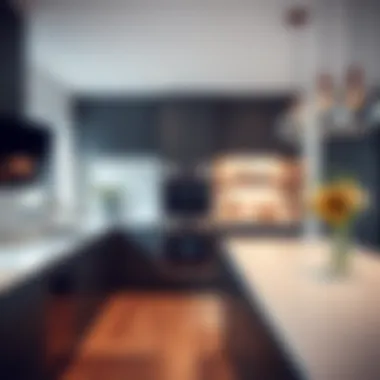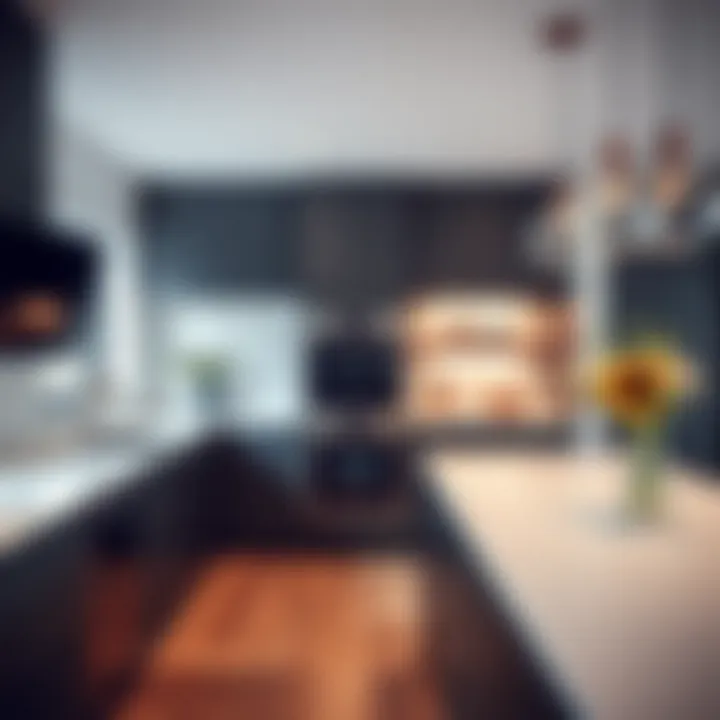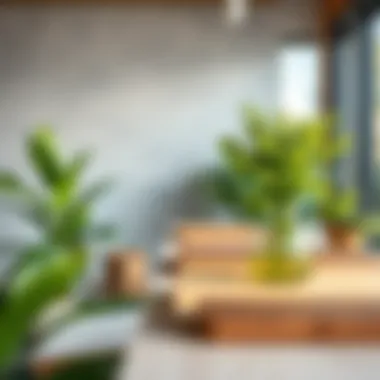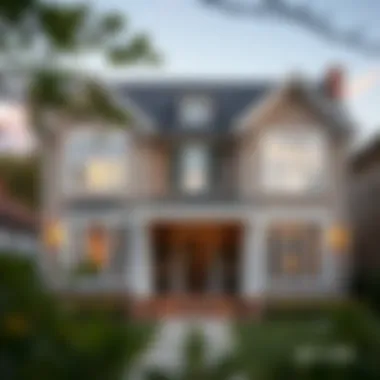In-Depth Guide to Home Renovations and Trends


Intro
Home renovations are more than just a pragmatic venture; they are a chance to reimagine the spaces we inhabit. Whether it's a modest fixer-upper or a sprawling estate, getting into the nitty-gritty of home improvements can yield substantial rewards both aesthetically and financially. Not only do renovations allow homeowners to express their personal tastes, but they can also dramatically enhance property value, attracting potential buyers when the time comes to sell.
Navigating the home renovation process can feel akin to wandering in a labyrinth—rich with choices and sometimes overwhelming complexities. From budgeting and choosing materials to selecting contractors and understanding building regulations, there is quite a hell of a lot to cover. This article will take you through the essential considerations that come with home renovations, including current market trends, investment opportunities, and effective strategies for maximizing returns on property listings.
Understanding Home Renovations
Home renovations can be a game-changer in real estate, transforming not just spaces but also lifestyles. This topic deserves attention as it expands beyond mere aesthetics; it encapsulates practicality, financial strategy, and emotional satisfaction. Whether one is a seasoned investor or a first-time homebuyer, understanding renovations is critical for a myriad of reasons.
One of the main reasons home renovations hold such importance today is their potential to increase property value. Buyers are often looking for move-in ready homes with modern upgrades. A well-planned renovation could see your home’s market price jump significantly. Besides financial implications, renovations can enhance functionality. An ideal kitchen design or a more spacious bathroom could make day-to-day living a lot smoother.
Additionally, as society evolves, so do preferences in design. Homeowners increasingly seek out ways to personalize their spaces. Renovations allow them to create an oasis that reflects their individuality. However, this personal touch shouldn’t overlook the trends that impact home desirability. An understanding of renovations thus informs decisions that not only improve living conditions but also align with market demands.
"Understanding home renovations is not merely a tactic for property improvement; it's a strategy for future success and personal satisfaction."
In summary, grasping the nuances of home renovations allows stakeholders—from investors to home dwellers—to make informed decisions. The benefits are multifaceted, influencing both individual enjoyment and overall investments.
Reasons for Renovating a Home
Home renovation is not merely a cosmetic upgrade; it’s often a strategic decision that impacts the functionality, value, and overall enjoyment of a property. When property owners contemplate renovations, they frequently set out on a journey that encompasses careful planning and thoughtful execution. The reasons for undertaking such projects can vary widely and are deeply rooted in personal preferences, market conditions, and even lifestyle changes. This section explores the fundamental motivations behind home renovations, dissecting how each reason contributes to the broader goals of property improvement.
Increasing Property Value
One of the driving forces behind home renovations is the potential for increasing property value. Investing in your home can lead to a better return on investment (ROI) when it comes time to sell. For instance, modernizing the kitchen and bathroom can significantly enhance the appeal of a home to prospective buyers. Recent studies show that a well-executed kitchen remodel can recover about 80% of the investment during resale, making it undeniably worthwhile. Sellers often find that features like stainless steel appliances, granite countertops, and open-concept layouts are hot commodities in today’s market.
"A house that too often is neglected will only cascade into depreciation. On the other hand, a renovation can work wonders, pulling it back from the brink of decline into one of value."
Conducting renovations in alignment with what buyers are currently seeking can be a powerful move. Staying abreast of trends, such as eco-friendly features or smart home technology, can not only elevate the market value but also broaden the pool of potential buyers.
Improving Functionality
Functionality is often overlooked during home renovations, yet it plays a crucial role in how a space is utilized. Older homes may not meet the dynamic needs of modern families, whose requirements can shift dramatically—from remote working arrangements to accommodating larger households. By redefining spaces, such as converting an unused basement into a livable area or reconfiguring rooms for open flow, homeowners can vastly improve day-to-day living.
Moreover, renovations targeting specific functionalities can help eliminate problematic layouts. For instance, expanding the kitchen for better cooking and socializing experiences—not just aesthetics—can lead to heightened satisfaction within the home. Homeowners often find that by focusing on how they live, rather than only on superficial upgrades, they create an environment that enhances their daily routines and overall lifestyle.
Personalization and Aesthetics
Beyond practicality, home renovations often serve as a canvas for personal expression. The desire to embed one’s individuality into a living space can transform a house into a true home. Installing decorative elements, custom cabinetry, or unique flooring options can immediately change how one feels about their environment.
Personalization goes beyond mere aesthetics; it’s a reflection of lifestyle choices and values. For example, homeowners who prioritize sustainability may choose reclaimed materials or energy-efficient systems, making a statement about their commitment to the environment while boosting visual appeal.
Ultimately, renovations provide an opportunity to align a space with personal taste and functionality. Homeowners often find joy in curating interior designs that resonate with them, turning merely functional spaces into tailored sanctuaries. The more a space embodies one’s nuanced preferences, the higher the emotional and psychological value it delivers.
In summary, understanding the reasons for renovating a home advances our insights into home improvement strategies. Whether driven by monetary gain, improved practicality, or personal expression, home renovation remains a complex yet rewarding venture. By acknowledging and acting on these motivations, property owners can make informed decisions that align with their goals.
Planning Your Renovation
Effective planning forms the backbone of any successful renovation project. Without a solid plan, renovations can spiral out of control, leading to unexpected costs and delays. First and foremost, setting clear objectives helps identify what you truly want from the renovation. This leap from concept to reality requires a holistic approach that encompasses budgeting, timelines, and hiring the right talent. Adhering to a well-structured plan not only simplifies the process but also ensures that the project adheres to your expectations while being economically viable.
Setting a Budget
Crafting a budget is often seen as one of the most crucial steps in the planning phase. It's not just about how much you’re willing to spend but also understanding where that money will go. Depending on what you aim to accomplish, certain components like labor costs, materials, and unexpected contingencies need to be taken into account. A good rule of thumb is to allocate around 10-20% of your total budget for unforeseen expenses.
When budgeting, consider the cost of similar renovations in your area, potential increases in property taxes, and potential returns on resale value to ensure your investment is well-placed. Being realistic from the get-go helps in making sound decisions.
Creating a Timeline
A timeline serves as a roadmap, guiding you through the different phases of a renovation. It’s vital to outline the start and end dates for various elements—design, demolition, construction, and inspection—to keep track of progress. Understanding that renovations rarely go perfectly as planned will help avoid frustration. Time frames might shift due to labor availability, permitting delays, or changing project scope.
By establishing a clear timeline, you set expectations not just for yourself but for your contractors too. That way, everyone involved knows what to aim for, allowing for efficient resource management, minimizing waiting times, and ensuring work flows smoothly.
Choosing the Right Contractors
Selecting the right contractor can be the difference between a smooth renovation experience and a series of headaches. It requires a careful approach:
Researching Credentials
Begin by researching the credentials of potential contractors. Look for licenses and certifications that demonstrate their qualifications and compliance with local regulations. Checking online platforms like Angie’s List or HomeAdvisor can lead to reliable reviews and feedback from previous clients. This due diligence can save you from hiring someone who might not meet professional standards, ultimately impacting work quality.
Assessing Past Work
Once you have narrowed down your choices, examine their past projects. This offers a glimpse of their craftsmanship and design style. Many contractors have portfolios that showcase previous work, providing you with a tangible reference to gauge their expertise. Pay attention to the quality of their finishes, attention to detail, and overall design coherence. Sometimes, a casual conversation about their experience and challenges faced in past projects can unveil a lot about their problem-solving capabilities.
Understanding Contracts
A well-structured contract is a safety net for both parties, clearly outlining the scope of the work, timelines, payment schedules, and warranty clauses. Don’t rush through this; take the time to understand each component of what you agree upon. By seeking legal advice, if necessary, you can ensure that the contract protects your interests while establishing clear expectations. This transparency will minimize disputes and keep the project on track.
Types of Home Renovations
Home renovations can significantly alter the character and functionality of a dwelling, making this category a cornerstone of property enhancement. This section delves into various home renovation types. Each type has not only its unique characteristics but also implications for the homeowner's lifestyle and property value. Understanding these can help homeowners and investors decide which projects to pursue, taking into account factors like budget, market trends, and personal preferences.
Kitchen Remodels
The kitchen is often the heart of a home, making it essential to invest in its renovation. A well-executed kitchen remodel can elevate both usability and aesthetic appeal.
Layout Changes
Layout changes in a kitchen can have a tremendous effect on how the space is utilized. By adjusting the arrangement of appliances, cabinets, and countertops, one can create flow and efficiency. For example, open floor designs allow for better social interaction, particularly during gatherings.
The key characteristic of layout changes is their ability to maximize kitchen efficiency. This feature makes it a popular choice in renovations today. Many homeowners opt for an island layout, which not only increases workspace but also serves as a casual dining area.
However, layout changes may require significant structural work, which can be a drawback in terms of time and cost. Homeowners should weigh these considerations against their goals for the kitchen space.


Modern Appliances
Incorporating modern appliances is another crucial element of kitchen remodels. These appliances are designed to be more energy efficient and technologically advanced. This not only contributes to lower utility bills but also increases the overall value of the home.
The key characteristic of modern appliances lies in their smart technology integration, which allows homeowners to control them remotely. This aspect has made them increasingly beneficial for busy lifestyles. They enhance convenience and usability, making meal prep easier than ever.
On the flip side, while modern appliances come with many advantages, they often pricier than their traditional counterparts. The upfront investment can be substantial, so budgeting wisely is necessary.
Storage Solutions
Good storage solutions ensure that a kitchen remains clutter-free and organized. This is vital, especially in urban settings where kitchen space may be limited.
The key characteristic of effective storage solutions is their versatility. Pull-out cabinets, lazy Susans, and concealed drawers can maximize space and maintain aesthetics, which makes them a popular renovation choice.
These unique features can drastically improve daily life by creating a more efficient working environment. However, one needs to consider that the cost of customized storage can vary, making it an important factor in budget planning.
Bathroom Upgrades
Bathrooms may not be the largest rooms in a home, but they greatly influence both personal comfort and real estate value. Upgrading fixtures, layout, and aesthetics can transform an outdated bathroom into a luxurious oasis.
Fixtures and Fittings
Updating fixtures and fittings is fundamental in a bathroom renovation. Modern faucets, sinks, and toilets can enhances both functionality and style.
The key characteristic of these upgrades is the balance between flexibility and design. Many homeowners now opt for stylish but practical fittings, aiming for a balance of aesthetics and usability, making them widely popular in remodeling projects.
One disadvantage to consider is that high-end fittings can escalate the costs rapidly, making financial planning important for those on a budget.
Shower and Bathtub Choices
Choosing the right shower and bathtub can define the bathroom experience. Whether it’s opting for a luxurious soaking tub or a sleek walk-in shower, these decisions impact relaxation and functionality.
The key characteristic of this choice is the range of styles available—from traditional clawfoot tubs to modern frameless showers, offering something for every taste. This extensive selection makes it a beneficial aspect of renovations.
However, space limitations can pose challenges. For instance, a larger bathtub can consume valuable floor space, something many urban dwellers cannot afford.
Design Trends
Staying in tune with current design trends can ensure that the upgraded bathroom remains appealing for years to come. Trends such as minimalist designs and sustainable materials are shaping modern renovations.
The key characteristic here is adaptability; homeowners can incorporate designs reflecting their taste while also enhancing home value. These trends are gaining traction in the renovation world as they resonate with broader lifestyle and environmental concerns.
The downside is that trends can change swiftly. Investing in something that may quickly become outdated may not be the best long-term strategy.
Living Room Enhancements
The living room serves as a primary gathering place in a home. Enhancements here can significantly improve comfort and style, promoting a welcoming atmosphere.
Flooring Options
Selecting the right flooring for a living room is essential as it sets the atmosphere for the entire space. Hardwood, laminate, or carpet each offers distinct advantages.
The key characteristic of various flooring options is the level of maintenance they require. Hardwood floors can provide a timeless look but may require regular upkeep, while laminate offers an easy-clean alternative. This flexibility makes flooring choice a critical renovation factor.
The downside is that high-quality flooring can be a hefty investment, impacting overall renovation budgets.
Lighting Improvements
Lighting plays a pivotal role in enhancing the ambiance of a living room. Well-placed light fixtures can affect mood and functionality.
The key characteristic here is the ability to control brightness through various fixtures—recessed lighting, table lamps, or chandeliers—allowing for versatility in ambiance. This adaptability makes lighting improvements a popular renovation choice.
However, determining the ideal lighting may require professional input, adding to expenses and complicating the renovation process.
Wall Treatments
Refreshing the walls with paint, wallpaper, or paneling can completely transform a living room. This allows homeowners to express their style while improving aesthetics.
The key characteristic of wall treatments is their ability to serve as a focal point or blend seamlessly with the décor. This versatility makes it a beneficial choice for enhancing the living space.
Nonetheless, the time involved in preparing walls and the costs associated with high-quality materials can be downsides.
Outdoor Spaces
Enhancing outdoor areas can increase a property's usability and value, providing a space for relaxation and entertainment. Renovations here include landscaping, patios, and pools, which can dramatically alter the home's exterior appearance.
Landscape Design
Well-thought-out landscape design can add both beauty and practicality to a home. Thoughtful plant selection and layout can foster a serene environment.
The key characteristic of landscape design is how it complements the home’s architecture, enhancing curb appeal. Many view it as a valuable aspect of renovation as it increases outdoor livability.
However, maintaining a flourishing landscape requires ongoing effort and can incur recurring costs, something to consider before diving in.
Patio and Deck Additions
Adding patios or decks can significantly extend the living space outside, fostering areas for gatherings and leisure.
The key characteristic of these additions is their function as social hubs, promoting outdoor activities and relaxation. These features are not only popular but add substantial value to homes.
On the downside, substantial outdoor renovations may require permits and considerable investment, which can deter some homeowners.
Pool Installations
Installing a pool can create a luxurious atmosphere and offers an excellent avenue for leisure and recreation.


The key characteristic of pools is their appeal in enhancing lifestyle and potentially increasing property value. This luxurious feature makes them a beneficial choice for many families.
Yet, it's essential to consider the maintenance costs and liability aspects associated with pool ownership, as these can add complexity to lifestyle and budgeting.
Understanding the various types of renovations can empower homeowners and investors to make informed choices, ensuring each project aligns with their functional needs and financial goals.
Sustainable Renovation Practices
Sustainable renovation practices are becoming a cornerstone in the discussions surrounding home renovations. As climate change looms large in conversations across the globe, homeowners and developers alike are seeking ways to contribute to environmental conservation while enhancing their living spaces. Embracing sustainability doesn’t just mitigate the environmental footpring; it often leads to cost savings in the long run as well. This section will delve into the essentials of sustainable renovation, from materials to energy efficiency, and offers thoughtful guidelines on how to approach renovations responsibly.
Using Eco-Friendly Materials
The choice of materials in renovations can significantly affect both environmental impact and the home's aesthetic. Eco-friendly materials not only reduce pollution and waste but also often provide equal, if not superior, performance compared to conventional options.
Some popular eco-friendly choices include:
- Bamboo Flooring: A fast-growing resource, bamboo not only looks excellent but is incredibly durable.
- Recycled Glass Tile: This material offers a unique visual appeal while reducing waste from landfills.
- Low-VOC Paints: These paints release fewer volatile organic compounds, minimizing health hazards while revitalizing walls.
By using these materials, one can strive for a home that is not just beautiful and functional, but kind to the planet. The selection often boils down to researching local suppliers who offer materials that meet environmental standards.
Energy-Efficient Solutions
Integrating energy-efficient solutions into renovation projects is paramount not only for environmental considerations but also for financial savings. Homes that effectively use energy operate at lower costs and can significantly improve one's carbon footprint.
Some methods to enhance energy efficiency include:
- Energy Star Appliances: These appliances use significantly less energy than their non-rated counterparts, translating to real savings on utility bills.
- Insulation Upgrades: Proper insulation in attics, walls, and floors can help retain indoor temperatures, reducing heating and cooling costs.
- Smart Thermostats: These devices learn inhabitants' schedules and adjust heating and cooling automatically, ensuring efficiency.
Investing in such solutions makes a home not only more comfortable but also increases its market value, aligning with buyer preferences for energy-conscious properties.
Waste Reduction Strategies
Waste reduction is a critical component of sustainable renovations, addressing the rampant issue of construction waste. The goal is to minimize what lands in a landfill while maximizing resource recovery.
Here are some effective strategies:
- Deconstruction over Demolition: Carefully dismantling instead of demolishing can salvage usable materials. Many organizations will even pick up donated materials, reducing disposal costs.
- Reusing Existing Structures: Whenever feasible, maintain original fixtures and fittings. This preserves the home's character while reducing the carbon impact associated with new productions.
- Sourcing Locally: By choosing local materials and labor, the carbon footprint associated with transportation is significantly lowered.
For the average homeowner or contractor, incorporating these waste reduction strategies not only supports sustainability but can also lead to financial savings through reduced disposal fees and a more manageable renovation process.
"Embracing sustainability in renovations isn't just a trend; it's a pivotal shift towards responsible living that benefits us all." - Property Expert
Regulatory Considerations
Navigating the world of home renovations isn't just about design choices and budgeting; it also involves a deep dive into regulatory considerations. These rules and requirements can feel like a tangled web, but understanding them is crucial. Foiling delays and expenses down the line often comes from being well-versed in building codes and obtaining the necessary permits. Let’s unpack these elements to grasp their significance in the renovation process.
Building Codes and Regulations
Building codes essentially serve as a safety net. They are the guidelines that ensure a structure is sound and secure for use. These regulations can vary significantly depending on where you live, so getting familiar with specific requirements in your area is key.
- Safety First: Building codes focus on aspects such as structural integrity, electrical standards, and fire safety. Taking shortcuts can lead to dire consequences, including not just monetary losses, but threats to personal safety.
- Insurance Implications: When you adhere to local codes, your home insurance remains valid. Failing to comply can leave you high and dry when trying to claim damages or losses.
- Future Resale: If you’re considering selling your home after renovations, buyers often look for properties that meet current standards. Non-compliance can impact your bottom line.
Building codes can often feel like a moving target due to changes in safety standards. Staying proactive about these requirements can save both headaches and financial pitfalls in the future. For more detailed explanations regarding local standards, check out resources on Wikipedia.
Permits and Approvals
Obtaining permits is another essential step in the renovation journey. Picture them as tickets that validate your project isn't just legal, but also viable. There are several key points to remember about permits:
- Types of Permits: Depending on what you’re up to, different permits are needed—whether it’s for structural changes or general electrical work.
- Application Process: Getting permits can be an administrative process. Often, you'll need to submit detailed plans and specifications for approval before the work can begin. Approaching this with thoroughness can help grease the wheels.
- Inspections: Post-renovation, inspections often become a requirement to ensure compliance with local codes. These checks can delay move-in dates if there’s any non-compliance.
- Cost Factors: Permit fees vary significantly and can sometimes catch you off guard. Filling out the required paperwork in advance can prevent unexpected costs that could hinder project momentum.
"Not all renovations require permits, but knowing when you do need them can save you from costly fines and project delays."
For detailed guidance, you can refer to local government websites like govinfo.gov to get specifics on permits in your area.
In summary, regulatory considerations are foundational to a successful home renovation. Knowledge of building codes and the permit process not only helps you dodge bureaucratic traps but also elevates your renovation from a mere project to a safe, well-executed transformation. This can significantly affect the value and livability of your home, making it a worthy investment.
Utilizing Technology in Renovations
In modern home renovations, the use of technology has become not just an enhancement, but rather a fundamental aspect of the process. Homeowners and investors seeking to optimize their renovation projects increasingly find themselves considering how technology can streamline tasks, improve efficiency, and even amplify creativity. The juggling act of managing budgets, schedules, and designs creates a need for tools that can help alleviate stress and lead to optimal outcomes. From smart home devices to innovative design tools, embracing technological advancements offers myriad benefits and considerations.
Smart Home Integration
Smart home integration refers to the incorporation of devices and systems that allow homeowners to manage their home's functionalities remotely and efficiently. This isn’t just about convenience; it’s also about enhancing safety, saving energy, and boosting overall property value.
- Convenience: Home automation systems allow for tasks like adjusting thermostats or controlling lighting to be done via smartphone apps. Imagine being able to turn on your porch light or adjust the heating from miles away—this can be particularly useful for vacation homes or properties that are frequently rented.
- Energy Efficiency: Smart technology can significantly reduce energy consumption. For example, smart thermostats learn a homeowner’s routines and adjust heating and cooling to minimize waste. This not only saves money but also appeals to eco-conscious buyers.
- Security: Many smart home systems incorporate security features such as surveillance cameras and alarm systems that can be monitored in real-time. This adds an extra layer of safety for families.
Ultimately, integrating smart technology into home renovations doesn’t just modernize the living space; it also makes the home more desirable and potentially increases its market value.
Virtual Design Tools
Virtual design tools have transformed how homeowners and developers approach interior and exterior layouts and designs. By using these tools, property owners can visualize their renovations before any actual work begins, which can prevent costly mistakes.
- 3D Modeling: Advanced software options, like SketchUp, enable users to create realistic 3D representations of their renovations. This offers a clear picture of how different elements come together, which can help in decision-making—say, if the new kitchen island fits the existing layout.
- Augmented Reality (AR): Some applications utilize AR to allow homeowners to visualize appliances, furniture, and designs in their actual space. This technology creates an immersive experience that can boost confidence in design choices.
- Cost Estimation Tools: Many virtual design programs come with features that help estimate costs based on selected materials and designs. This means that users can play around with different styles without risking their budget.
Utilizing virtual design tools not only simplifies the planning process but also enhances communication between homeowners and contractors. This leads to smoother renovations and, in many cases, a more satisfying end product.
"Technology is more than just a tool; it's an essential partner in transforming your home."
Post-Renovation Considerations
After the paint has dried and those shiny new fixtures are in place, the excitement of a renovation can create a sense of accomplishment. However, the journey isn't quite over. Post-renovation considerations take center stage, as they ensure that everything runs smoothly, stays pristine, and remains functional. Neglecting this stage can lead to a host of challenges down the road.
Being proactive about evaluating your renovations can not only save you from costly repairs later on but also enhance your satisfaction with the work completed. After all, renovations often represent a significant investment and a deeper attachment to your property.
Evaluating the Outcome
Assessing the effectiveness of your renovation is step one. This is about more than admiring your new kitchen; it’s about critically analyzing whether the physical changes align with your initial goals. Consider these aspects:
- Aesthetic Appeal: Is the design pleasing to your eye? Does it fit with the overall style of your home?
- Functionality: Are you better able to navigate and utilize the space? Does your new layout facilitate daily activities?
- Quality of Work: Did the contractors maintain a high standard? Look for gaps, misalignment, or other signs that might suggest poor workmanship.
Feedback from family or friends can be invaluable during this assessment phase. Don't hesitate to ask for their candid opinions. They might point out something you've overlooked.
"Successful renovations don't just improve a home; they enhance the owner's daily life."
Keeping a record of your evaluations can also help if you encounter issues later. Document findings and follow up with your contractors, especially when it comes to warranty work.


Maintenance and Care
Once everything looks good and functions well, the next up is maintenance. This is a critical element that often gets sidelined amidst the excitement of completion. Some maintenance tasks may include:
- Routine Inspections: At least twice a year, check areas prone to moisture, like bathrooms and kitchens. Look for signs of leaks, mold, or wear and tear.
- Cleaning: High-quality materials can only shine if maintained properly. Regular cleaning schedules should be established to keep appliances, fixtures, and finishes in top condition.
- Documentation: Keeping detailed records of all renovations and maintenance performed can build a solid history of your home. This can greatly benefit you down the line, particularly during resale.
Creating a simple yet effective maintenance checklist can keep you on track without letting potential issues crop up into costly repairs. This practice not only preserves your investment but also ensures that your renovated spaces remain enjoyable for years to come.
For further guidance on home maintenance, you can explore resources like HomeAdvisor and This Old House.
Real Estate Market Trends Influencing Renovations
Understanding the dynamic nature of the real estate market is imperative for anyone involved in home renovations. The trends that percolate through the market can heavily influence decisions related to property enhancements, thereby impacting investment returns and personal satisfaction. This section dives into the core elements shaping renovations today, pointing out why these trends matter, how they can enhance property value, and what considerations buyers and investors should keep in mind.
Current Buyer Preferences
With each passing year, buyer preferences evolve, often reflecting broader societal shifts. For instance, many buyers now prioritize open-plan living spaces that seamlessly blend the kitchen, dining, and living areas. This change is often linked to a desire for more interaction among family members, especially during gatherings.
In addition to layout changes, sustainability has emerged as a significant factor in buyer preferences. Modern homeowners are increasingly looking for energy-efficient options and materials that reduce their carbon footprint. Features such as solar panels, energy-efficient lighting, and locally sourced materials are gaining traction.
Here are some key preferences currently prevalent among buyers:
- Smart Home Features: Buyers favor homes equipped with smart thermostats, security systems, and appliances. These innovations add convenience, safety, and often, energy savings.
- Outdoor Living Spaces: With the recent emphasis on home environments, outdoor areas have become as crucial as interiors. Patios, deck installs, and landscaped yards are sought after.
- Low-Maintenance Materials: Many buyers lean towards materials that don’t require constant upkeep, such as vinyl siding or quartz countertops, allowing for more leisure time.
By keeping an ear to the ground on these trends, renovators can tailor their projects to create spaces that attract potential buyers.
Investment Returns on Renovations
When considering renovations, it is essential to keep a close eye on return on investment (ROI). Home improvements can significantly increase property values, but not all renovations yield the same financial benefits. Understanding which updates appeal to buyers can help home flippers and long-term investors maximize their earnings.
Some of the most lucrative renovations include:
- Kitchen Remodels: Updating kitchen fixtures or even doing a full remodel often yields one of the highest ROI percentages. Modern appliances, ample storage, and aesthetic appeal are crucial here.
- Bathroom Upgrades: According to countless studies, bathroom renovations can recoup a lot of their costs upon sale. Simple changes like modernizing taps and tiles can make a dramatic impact.
- Curb Appeal Enhancements: Investing in the home's exterior — like painting, siding, or landscaping — can dramatically affect perceptions and improve potential offers.
To put it simply, if you want to hit the nail on the head with renovations, align them with market demand. As old adages go, “you've got to spend money to make money,” and being smart about renovations could mean putting cash back in your pocket when it’s time to sell.
"Home renovations, when done right, not only cater to current trends but also prepare homeowners for future returns on their investments."
With these considerations in mind, it’s easy to see how keeping up with the ever-changing real estate market can pay off when embarking on a renovation project.
Case Studies in Renovation Success
Examining successes in home renovations offers invaluable insights that can inform future projects and decisions. These case studies not only showcase innovative approaches to design and updates but also highlight the practical challenges faced during the renovation process. Understanding the dynamics behind completed renovations allows investors, realtors, and property managers to evaluate the tangible and intangible benefits of these projects. By analyzing specific elements of noteworthy renovations, one can uncover practices that yield greater satisfaction and return on investment.
Noteworthy Projects
When discussing exemplary renovations, several projects stand out due to their profound impact on property value and homeowner delight. For instance, let's look at a historical brownstone in Brooklyn, New York.
- The Brooklyn Brownstone Revival: This project involved a complete restoration of the interior while retaining the building's classic façade. By combining modern amenities with historical features, such as original moldings and plasterwork, the owners transformed the space. The result was an increase in property value by over 40%.
- The Eco-Friendly Apartment: In a bid to go green, a couple in Seattle undertook a major renovation of their urban apartment, implementing solar panels, reclaimed wood, and energy-efficient appliances. Their commitment to sustainability not only improved their living space but also drew in environmentally-conscious buyers when they eventually sold, maximizing returns on their investment.
- The Loft Conversion: A garage in San Francisco was turned into a modern living loft with an open plan and industrial finishes. This conversion reflected the latest urban lifestyle trends and attracted a high-paying renter, thus increasing rental income by 60%. This showcased how understanding market preferences can guide renovation decisions effectively.
Each of these projects demonstrates how a thoughtful approach to renovation can yield substantial rewards. From restoring historical features to incorporating modern conveniences and sustainability, the possibilities in renovations are as diverse as they are appealing.
Lessons Learned
Reflecting on these projects illuminates important lessons for anyone considering a renovation. Here are some key takeaways:
- Balancing Tradition and Modernity: It’s essential to be mindful of the home’s historical character while integrating modern functionality. Renovations should respect the original architecture to appeal to prospective buyers who value history.
- Investing in Sustainability: Eco-friendly upgrades are not just buzzwords. Adapting renovations to include energy-efficient installations can lower long-term costs and heighten property value in an increasingly green-focused market.
- Market Alignment: Knowing the market is pivotal. Renovating without clear demand can lead to overspending without returns. A renovation should align with what potential buyers or tenants are looking for in a property.
"Renovations should be as much about future-proofing the property as they are about improving the present."
Navigating Challenges in Renovation Projects
Home renovations can be an exciting yet daunting endeavor, filled with opportunities for creativity and improvement. However, the road to achieving your vision often presents various challenges that can derail even the best-laid plans. Understanding how to navigate these issues is vital for anyone involved in the renovation process, from investors to property managers. This section highlights the importance of recognizing potential hurdles and developing strategies to mitigate their impact, ensuring that your renovation project progresses smoothly.
Common Hurdles
- Budget Overruns
Unforeseen expenses can quickly escalate your budget beyond expectations. Often, homeowners underestimate the costs associated with labor, materials, or permit fees. Failure to address this can leave your project half-finished or in a financial bind. - Supply Chain Issues
The current market conditions have given rise to supply chain disruptions, making it harder to source materials on time. Whether it’s lumber, tiles, or appliances, delays in procurement can stall your project significantly. - Structural Constraints
Older homes can surprise you with hidden issues such as outdated electrical systems or plumbing problems. These structural constraints can delay your renovation or lead to costly changes in plans. - Regulatory Compliance
Navigating local building codes and laws can be tricky. If not properly adhered to, you could face fines or have to redo work to meet regulations. - Contractor Challenges
Selecting the right contractor is essential. Miscommunication, mismatched expectations, or poor performance can complicate the renovation process and lead to dissatisfaction with the end product.
"Expect the unexpected; it's part of the renovation journey."
Mitigation Strategies
To tackle these hurdles effectively, consider the following strategies:
- Thorough Planning
Create a comprehensive renovation plan that encompasses all aspects, including a detailed budget and timelines. This foresight will help you manage expectations and minimize surprises. - Communicate Openly
Maintain an open line of communication with contractors and suppliers. Regular updates can prevent misunderstandings and keep everyone on the same page regarding expectations and timelines. - Contingency Funds
Always set aside a portion of your budget as a contingency fund. This hidden stash becomes your safety net for any unexpected issues that might crop up along the way. - Research Local Codes
Familiarize yourself with local regulations. It can save you from costly mistakes down the road and show your contractor that you are informed. - Due Diligence in Contractor Selection
Invest time in researching potential contractors. Assess their credentials, read reviews, and if possible, visit previous projects. A solid contractor will understand the importance of delivering on time and within budget.
In essence, navigating the complexities of renovation projects involves a combination of strategic planning, effective communication, and a proactive approach to problem-solving. By anticipating common hurdles and preparing accordingly, you can turn potential pitfalls into stepping stones on your path to a successfully renovated home.
The Future of Home Renovations
In an era where the essence of home living is continuously evolving, understanding the future of home renovations takes center stage. This section dives into how not only aesthetics but also functionality and sustainability are shaping the next wave of renovations. Indeed, it’s not about just making a home look good anymore; it’s about optimizing for efficiency, comfort, and increased market value. Homeowners, investors, and developers alike must keep an eye on shifting trends to ensure their renovations meet the expectations of a changing market.
Emerging Trends
The landscape of home renovations has begun to pivot towards several noteworthy trends that reflect the priorities of today's homeowners. Here are the key themes that are gaining popularity:
- Smart Home Technology: As homes become increasingly automated, prospective renovators are looking for ways to integrate technology that enhances their living spaces. From smart thermostats like the Nest to advanced security systems, these gadgets not only add a layer of convenience but also promote energy efficiency.
- Sustainable Building Practices: Use of eco-friendly materials continues to rise, with many homeowners opting for sustainable options. This includes everything from bamboo flooring to reclaimed wood accents, which not only reduce one’s carbon footprint but also offer unique charm.
- Multi-Functional Spaces: The pandemic has seen a surge in demand for versatile living areas. Homes are being redesigned to accommodate work-from-home setups without compromising on personal spaces, leading to innovative solutions like built-in desks and fold-out furniture.
- Outdoor Living: Enhanced focus on outdoor spaces is another significant trend. Homeowners are investing more in backyards, creating inviting areas with fully equipped kitchens, fire pits, and comfortable lounge spots that extend their living areas into nature.
These emerging trends reveal a future where renovations are not just about upkeep but about enhancing lifestyle, providing functionality, and ensuring sustainability.
Innovations in Design
The design aspect of home renovations is rapidly evolving, showcasing innovations that address both aesthetic and functional needs. Here are some highlights:
- 3D Printing: This advanced technique is making its way into building materials, allowing for designs that were previously too complex or costly. Walls and furniture can now be printed to exact specifications, leading to both efficiency and creativity in design.
- Biophilic Design: Incorporating elements of nature into living spaces is gaining traction. Homeowners are looking to create environments that promote well-being by integrating natural light, ventilation, and even living walls.
- Modular Design: Flexibility in design is highly sought after. Modular components allow homes to be adaptable, facilitating easy changes in layout or function based on changing needs.
- Color Trends and Textures: As tastes evolve, so do colors and materials. From calming earthy palettes to bold, vibrant hues, the future of design is more experimental and personalized, ensuring each home tells a unique story.
Ultimately, the innovations in design are not just about following trends, but about embracing solutions that cater to the evolving lifestyles of homeowners. With these advancements, the focus is now on creating spaces that inspire and nurture.
"A home is not just a place; it’s an experience. Renovations must reflect this philosophy to resonate with today’s homeowner."
By keeping track of these innovations, investors and homeowners can make strategic decisions that not only enhance their living spaces but also contribute to the overall market appeal of their property, ensuring long-term value and satisfaction.















